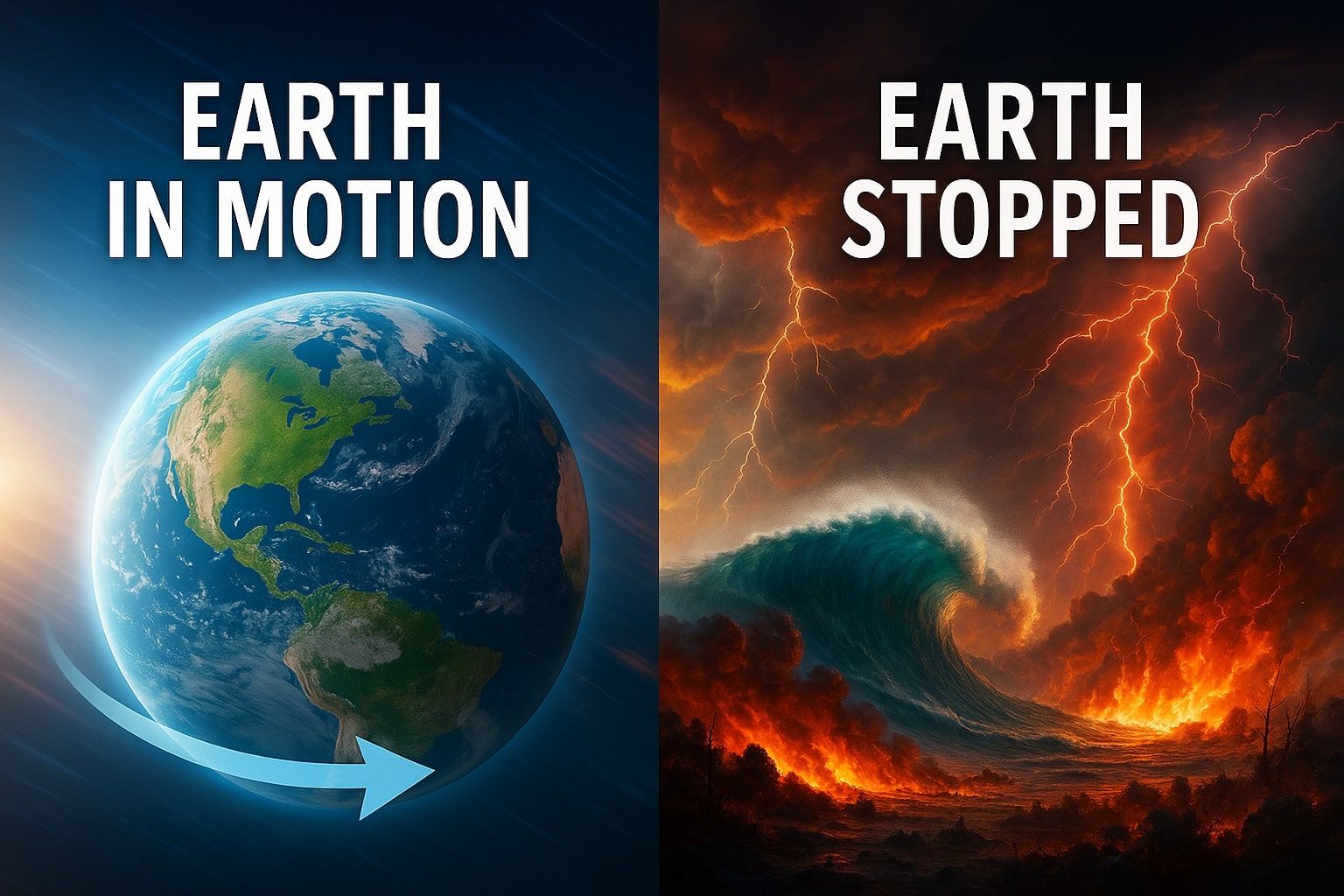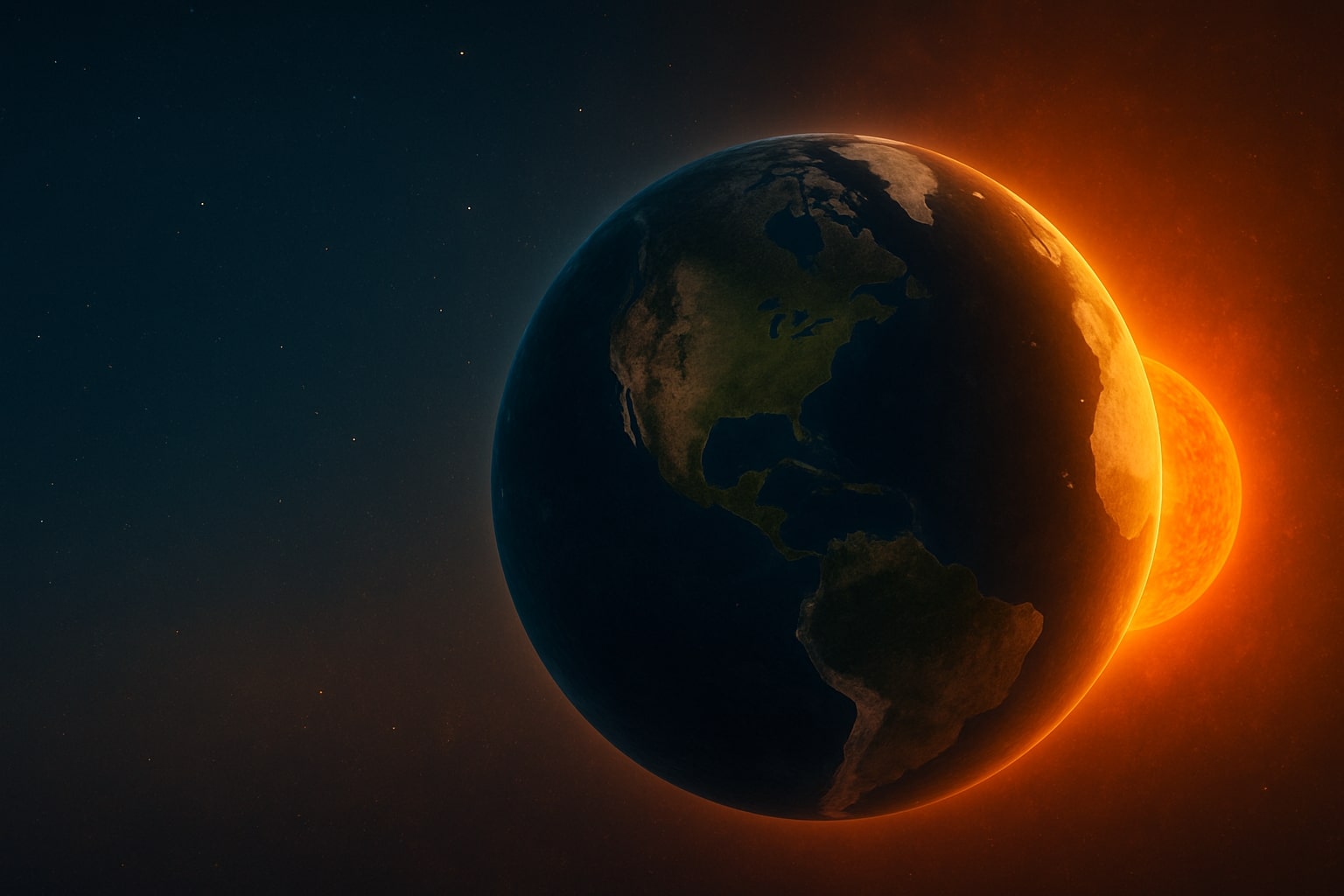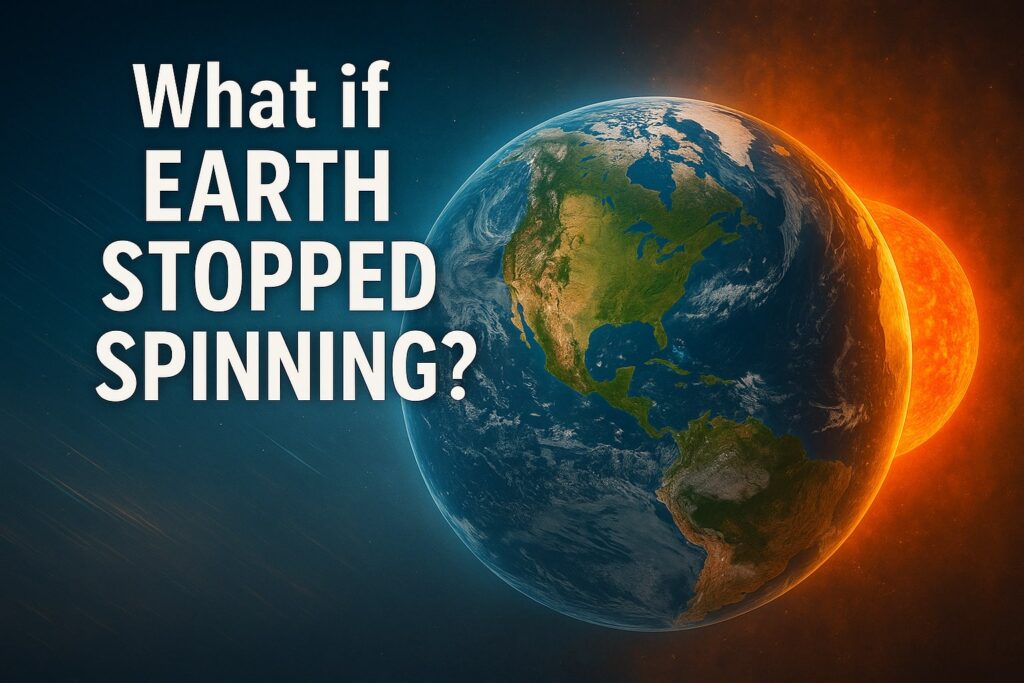Table of Contents
Toggle🌀 Introduction: A Planet in Motion
What if Earth stopped spinning — even for just one minute?
It sounds like the plot of a sci-fi disaster movie, but this question opens the door to some of the most intense physics imaginable. Earth spins at over 1,670 km/h (1,038 mph) at the equator, and that constant rotation is the reason we have day and night, stable weather patterns, and even a protective magnetic field.
But if that rotation were to halt — just for 60 seconds — the consequences would be nothing short of apocalyptic.
In this expanded article, we’ll explore:
The science behind Earth’s rotation
Inertia and its terrifying role
Massive global destruction from air, water, and land
Climate shifts and long-term chaos
What would happen after the spin resumes
Whether anything could survive
Let’s break down this unimaginable scenario, step-by-step.

🧠 Earth’s Rotation: The Cosmic Ballet
Earth’s rotation began billions of years ago during its formation from the solar nebula. As material condensed under gravity, it started spinning — and has never stopped.
🔄 Key Functions of Earth’s Rotation:
Creates Day and Night: Earth spins west to east, making the Sun appear to rise and set.
Shapes Weather Systems: Via the Coriolis Effect, it curves winds and ocean currents, forming cyclones and jet streams.
Supports a Balanced Gravity: Centrifugal force slightly reduces gravity at the equator.
Powers the Magnetic Field: The spin contributes to Earth’s molten outer core movement, generating the magnetic field that protects us from solar radiation.
Earth is essentially a massive gyroscope — halting it abruptly would violate Newton’s Laws in catastrophic ways.
⏱ One Minute of Horror: What Happens If Earth Stopped Spinning?
Imagine this:
Suddenly, with no warning, Earth’s crust comes to a dead stop.
But its atmosphere, oceans, and everything on the surface still move at the original speed.
Even for just one minute, the consequences would be akin to an apocalyptic event.
Let’s simulate this second by second.
⏱ The First 10 Seconds: Inertia Turns Deadly
Newton’s First Law of Motion tells us that anything in motion stays in motion unless acted upon.
So when Earth stops but the rest of the world doesn’t…
🔥 Here's what happens:
Cars, buildings, trees, people, animals — everything — gets flung eastward at over 1,000 mph.
Structures shatter instantly.
The air keeps moving — creating hyper-hurricane-force winds.
Planes lose control and crash.
Trains derail. Power grids snap.
Imagine 1,000+ Hiroshima bombs worth of energy released across the globe… simultaneously.
🌊 10–30 Seconds: Oceans Go Rogue
The oceans, too, are still “moving” due to momentum.
🌐 What this causes:
Mega-tsunamis form as water surges eastward.
Entire coastlines — like New York, Tokyo, Mumbai — vanish under waves.
Water slams into inland areas at speeds never seen in history.
Rivers reverse, reservoirs burst, and lowlands flood completely.
Tsunamis as high as 1–2 km (yes, kilometers!) may occur.
🌬 30–60 Seconds: Atmospheric Chaos
With air and water slamming into stationary landmasses, heat builds u
🔥 Friction leads to:
Firestorms across forests and cities.
Tornado-like vortices across the planet.
Massive electrical discharges and atmospheric lightning.
Buildings stripped clean by intense winds.
Dust storms in deserts like the Sahara become continent-wide sand blizzards.

🌊 Oceans in Chaos: Tsunamis If Earth Stops Spinning
One of the worst consequences when Earth stops spinning is the behavior of oceans.
Water inertia causes walls of water to race across continents
Coastal populations are obliterated
Rivers reverse direction; seas become unrecognizable
🧍 Human Survivability: Almost Zero
Humans, being fragile biological organisms, would be at the mercy of these violent forces.
👨👩👧 Immediate outcomes:
Anyone outside or near windows is instantly killed or injured by debris or acceleration.
Underground shelters or deep-sea submarines might provide momentary refuge — but not from everything.
Nuclear reactors may melt down due to grid failure.
Millions — possibly billions — die within seconds.
The worst-hit areas? Equatorial regions, where spin speed is highest.
Polar regions might fare slightly better… but not for long.
🗺 Continental Chaos: Global Breakdown
Let’s look at continent-specific effects:
🌍 Africa & Asia:
Monsoons distort. Mega-tsunamis destroy Indian Ocean cities.
The Nile reverses. Himalayan glaciers collapse.
Earthquakes erupt in tectonic hotspots (Japan, Himalayas, Indonesia).
🌎 North & South America:
Pacific water floods California, Mexico, Chile.
Hurricanes strike both coasts.
The Great Lakes become inland oceans due to atmospheric drag.
🌍 Europe:
Windstorms level entire towns.
River overflows across Netherlands, Germany, and France.
Structural collapses due to air impact.
🌐 What Happens After One Minute?
Suppose Earth restarts its spin — back to normal — just as abruptly.
That creates another inertia shift, this time in reverse. New destruction follows.
The planet might survive, but civilization wouldn’t.
🧱 Long-Term Aftereffects:
Climate collapses: oceans displaced, jet streams gone.
Magnetic field weakens or halts.
Animals lose their biological rhythms.
Satellite systems and GPS become useless.
Recovery takes centuries, if possible.
🔋 Earth's Magnetic Field and Core Disruption
Earth’s magnetic field — our shield against solar radiation — is powered by molten iron moving due to spin.
🧲 If the spin stops:
The core slows. Dynamo weakens.
Magnetic field collapses.
Earth becomes exposed to cosmic radiation and solar flares.
Aurora Borealis disappears. Satellites fry. Skin cancers surge.
Life becomes less protected, especially on surface-level biospheres.
🧪 Could It Ever Happen?
Short answer: No — not without breaking the laws of physics.
But let’s entertain a few sci-fi possibilities:
Massive Asteroid Impact: A planetary-sized object could alter rotation.
Alien Technology: Advanced civilizations with gravity control?
Black Hole Encounter: A rogue black hole could gravitationally interact with Earth.
Artificial Experiment Gone Wrong: Hypothetical tech experiments manipulating angular momentum.
All of these are purely speculative.
📈 Real Science: Earth Is Slowing Down
Though not stopping suddenly, Earth’s rotation is gradually slowing:
Tidal Friction caused by the Moon pulls energy from Earth.
Every century, the day becomes about 1.7 milliseconds longer.
Millions of years from now, Earth may become tidally locked — one side permanently facing the Sun.
So yes, spin does change… just very, very slowly.
🕵️♂️ Case Studies: Fiction That Explored This
🎥 Movies and Documentaries:
The Day the Earth Stood Still (1951 & 2008): Fictional alien interference with Earth.
Geostorm: Tech causes climate disasters — showcasing potential ripple effects.
The Core: Explores what happens if Earth’s core/magnetic field fails.
While exaggerated, these films illustrate the fragility of planetary systems.
🧭 Could Life Recover?
In the long term — if any humans survived and Earth’s spin resumed:
New climate patterns would emerge.
Animal migrations would shift permanently.
Agriculture fails, ecosystems collapse.
Earth might re-stabilize after thousands of years — but not for current civilizations.
Recovery would depend on how much of Earth’s biosphere and biodiversity survived.
🧠 Final Thoughts: The Fragile Dance of Motion
Our planet is a precisely tuned engine of motion and balance.
This imaginary pause in rotation reminds us how everything we know — weather, life, seasons, protection — depends on Earth’s constant spin.
So the next time you watch a sunset or feel a breeze, remember…
It’s only possible because our Earth never stops spinning.
If you love deep-dive thought experiments, cutting-edge space science, and extreme Earth scenarios, follow TechWithNK for more epic content.visit nasa for see amazing view of earth https://science.nasa.gov/earth/
🔔 Bookmark us | 💬 Leave a comment | 📤 Share this p
Can Earth really stop spinning?
No. Without immense external force, Earth’s momentum keeps it rotating indefinitely.
What would happen if Earth stopped for one minute?
Everything would keep moving at Earth’s former speed — creating global devastation from inertia, winds, and tsunamis.
How long does a full Earth rotation take?
About 23 hours, 56 minutes, and 4 seconds — known as a sidereal day.










